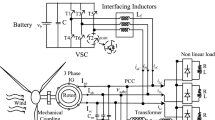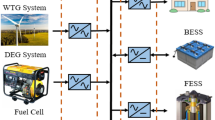Abstract
In this paper, an improved optimization algorithm is proposed to overcome the original Rao algorithm limitations (i.e., different characteristics in exploration and exploitation) and enhance the performance of the original Rao algorithm. In the improved algorithm, the self-adaptive multi-population and Levy flight methods are utilized in the original Rao algorithm. The improved algorithm is called I_Rao_3. The improved algorithm’s efficiency is confirmed by comparing it to the original Rao algorithm utilizing various standard benchmark test functions. Moreover, the proposed I_Rao_3 algorithm is utilized to improve the frequency response in a hybrid renewable power grid by fine-tuning the proportional-integral-derivative (PID) controller parameters. The targeted system used for this study is a hybrid power grid, which encompasses conventional generating stations (i.e., thermal power plants), renewable power stations (i.e., PV and wind power stations) for the analysis of the load frequency control (LFC) issue. Unlike other previously published works, this study considers the impact of DC links in parallel to AC links to interconnect the two-hybrid renewable power system area. In addition, the nonlinearities effects (i.e., generation rate constraint and a governor dead band) are applied to each area in order to achieve a more realistic study. The superiority of the proposed PID controller-based I_Rao_3 algorithm is endorsed by comparing its performance with many other optimization algorithms.



















Similar content being viewed by others
References
Ali H, Magdy G, Xu D (2021) A new optimal robust controller for frequency stability of interconnected hybrid microgrids considering non-inertia sources and uncertainties. Int J Electr Power Energy Syst 128:106651
Magdy G, Shabib G, Elbaset AA, Kerdphol T, Qudaih YS, Mitani Y (2019) Decentralized optimal LFC for areal hybrid power system considering renewable energy sources. J Eng Sci Technol 14(2):682–697
Liao K, Xu Y (2018) A robust load frequency control scheme for power systems based on second-order sliding mode and extended disturbance observer. IEEE Trans Ind Inform 14(7):3076–3086
Akula SK, Salehfar H (2019) Frequency control in microgrid communities using neural networks. In: North American power symposium (NAPS), Wichita, KS, USA
Chen G, Li Z, Zhang Z, Li S (2020) An improved ACO algorithm optimized fuzzy PID controller for load frequency control in multi area interconnected power systems. IEEE Access 8:6429–6447
Yousef H (2015) Adaptive fuzzy logic load frequency control of multi-area power system. Int J Electr Power Energy Syst 68:384–395
Zhang H, Liu J, Xu S (2020) H-infinity load frequency control of networked power systems via an event-triggered scheme. IEEE Trans Industr Electron 67(8):7104–7113
Ali H et al (2019) A new frequency control strategy in an islanded microgrid using virtual inertia control-based coefficient diagram method. IEEE Access 7:16979–16990
Bevrani H, Feizi MR, Ataee S (2016) Robust frequency control in an islanded microgrid: H∞ and μ -synthesis approaches. IEEE Trans Smart Grid 7(2):706–717
Shabib G, Mohamed TH, Abrdelhameed EH, Khamies M (2015) An advanced linear quadratic regulator for load frequency. In: 17th international middle east power systems conference, Mansoura, Egypt
Shabib G, Mohamed TH, Abrdelhameed EH, Khamies M, Qudaih Y (2016) Load frequency control in single area system using model predictive control and linear quadratic gaussian techniques. Int J Electr Energy 3(3):141–144
Moon YH, Ryu HS, Kim B, Song KB (2000) Optimal tracking approach to load frequency control in power systems. In: 2000 IEEE power engineering society winter meeting. Conference proceedings, Singapore
Aoki M (1968) Control of large-scale dynamic systems by aggregation. IEEE Trans Autom Control 13(3):246–253
Topno PN, Chanana S (2016) Load frequency control of a two-area multi-source power system using a tilt integral derivative controller. J Vib Control 24(1):110–125
Gozde H, Taplamacioglu MC, Kocaarslan I (2012) Comparative performance analysis of artificial bee colony algorithm in automatic generation control for interconnected reheat thermal power system. Electr Power Energy Syst 42:167–178
Hasanien HM, El-Fergany A (2019) Salp swarm algorithm-based optimal load frequency control of hybrid renewable power systems with communication delay and excitation cross-coupling effect. Electr Power Syst Res 176:1–10
Hasanien HM (2018) Whale optimisation algorithm for automatic generation control of interconnected modern power systems including renewable energy sources. IET Gener Transm Distrib 12(3):607–614
Khamies M, Magdy G, Hussein ME, Banakhr FA, Kamel S (2020) An efficient control strategy for enhancing frequency stability of multi-area power system considering high wind energy penetration. IEEE Access 8:140062–140078
Abubakr H, Mohamed TH, Hussein MM, Guerrero JM, Agundis-Tinajero G (2021) Adaptive frequency regulation strategy in multi-area microgrids including renewable energy and electric vehicles supported by virtual inertia. Int J Electr Power Energy Syst 129:106814
Duong M, Pham T, Nguyen T, Doan A, Tran H (2019) Determination of optimal location and sizing of solar photovoltaic distribution generation units in radial distribution systems. Energies 12(1):174
Nguyen TT, Nguyen TT, Duong MQ, Doan AT (2019) Optimal operation of transmission power networks by using improved stochastic fractal search algorithm. Neural Comput Appl 32(13):9129–9164
Khamies M, Magdy G, Ebeed M, Kamel S (2021) A robust PID controller based on linear quadratic gaussian approach for improving frequency stability of power systems considering renewables. ISA Transactions
Khadanga RK, Kumar A, Panda S (2021) A novel sine augmented scaled sine cosine algorithm for frequency control issues of a hybrid distributed two-area power system. Neural Comput Appl
Rao RV (2020) Rao algorithms: three metaphor-less simple algorithms for solving optimization problems. Int J Ind Eng Comput 11(1):107–130
Sultan HM, Kuznetsov ON, Menesy AS, Kamel S (2020) Optimal configuration of a grid-connected hybrid PV/wind/hydro-pumped storage power system based on a novel optimization algorithm. In: 2020 international youth conference on radio electronics, electrical and power engineering (REEPE), Moscow, Russia
Dede T, Grzywıńskı M, Rao RV (2020) The size optimization of steel braced barrel vault structure by using Rao-1 algorithm. Sigma J Eng Nat Sci 38(3):1415–1425
Premkumar M, Babu TS, Umashankar S, Sowmya R (2020) A new metaphor-less algorithms for the photovoltaic cell parameter estimation. Optik 208:164559
Rao RV, Pawar RB (2020) Constrained design optimization of selected mechanical system components using Rao algorithms. Appl Soft Comput 89:106141
Rao RV, Pawar RB (2020) Self-adaptive multi-population rao algorithms for engineering design optimization. Appl Artif Intell 34(3):187–250
Liu X, Wang Z, Wang L, Huang C, Luo X (2021) A hybrid rao-NM algorithm for image template matching. Entropy 23(6):678
Lekouaghet B, Boukabou A, Boubakir C (2021) Estimation of the photovoltaic cells/modules parameters using an improved Rao-based chaotic optimization technique. Energy Convers Manag 229:113722
Rao RV, Pawar RB (2020) Quasi-oppositional-based Rao algorithms for multi-objective design optimization of selected heat sinks. J Comput Des Eng 7(6):830–863
Venkata Rao R, Saroj A (2017) A self-adaptive multi-population based Jaya algorithm for engineering optimization. Swarm Evol Comput 37:1–26
Li C, Yang S (2008) Fast multi-swarm optimization for dynamic optimization problems. In 2008 fourth international conference on natural computation
Turky AM, Abdullah S (2014) A multi-population harmony search algorithm with external archive for dynamic optimization problems. Inf Sci 272:84–95
Fuel report — October 2019 (2019) International energy agency. https://www.iea.org/reports/renewables-2019
Global Wind Energy Council (GWEC) (2019) Global wind report annual market update 2019. http://www.gwec.net
Global market outlook for photovoltaics 2015–2019, http://www.pvresources.com
Magdy G, Mohamed EA, Shabib G, Elbaset AA, Mitani Y (2018) SMES based a new PID controller for frequency stability of a real hybrid power system considering high wind power penetration. IET Renew Power Gener 12(11):1304–1313
Nizamuddina I, Bhattib TS (2014) AGC of two area power system interconnected by AC/DC links with diverse sources in each area. Int J Electr Power Energy Syst 55:297–304
Ganapathy S, Velusami S (2010) MOEA based design of decentralized controllers for LFC of interconnected power systems with nonlinearities, AC–DC paralleltie-lines and SMES units. Energy Convers Manag 51:873–880
Abubakr H, Hussein MM, Mohamed TH (2020) Frequency stabilization of two area power system interconnected by AC/DC Links using jaya algorithm. Int J Adv Sci Technol 29(1):548–559
Magdy G, Shabib G, Elbaset AA, Mitani Y (2019) A Novel Coordination scheme of virtual inertia control and digital protection for microgrid dynamic security considering high renewable energy penetration. IET Renew Power Gener 13(3):462–474
Lotfy M, Senjyu T, Farahat M, Abdel-Gawad A, Yona A (2017) A frequency control approach for hybrid power system using multi-objective optimization. Energies 10(1):80
Mohseni S, Brent AC, Burmester D (2020) A comparison of metaheuristics for the optimal capacity planning of an isolated, battery-less, hydrogen-based micro-grid. Appl Energy 259:114224
Mirjalili S (2015) The ant lion optimizer. Adv Eng Softw 83:80–98
Zeng G-Q, Xie X-Q, Chen M-R, Weng J (2019) Adaptive population extremal optimization-based PID neural network for multivariable nonlinear control systems. Swarm Evol Comput 44:320–334
Derrac J, García S, Molina D, Herrera F (2011) A practical tutorial on the use of nonparametric statistical tests as a methodology for comparing evolutionary and swarm intelligence algorithms. Swarm Evol Comput 1(1):3–18
Hasanien HM, El-Fergany AA (2017) Symbiotic organisms search algorithm for automatic generation control of interconnected power systems including wind farms. IET Gener Transm Distrib 11(7):1692–1700
El-Hameed MA, El-Fergany AA (2016) Water cycle algorithm-based load frequency controller for interconnected power systems comprising non-linearity. IET Gener Transm Distrib 10(15):3950–3961
Ali ES, Abd-Elazim SM (2013) BFOA based design of PID controller for two area load frequency control with nonlinearities. Int J Electr Power Energy Syst 51:224–231
Author information
Authors and Affiliations
Corresponding author
Ethics declarations
Conflicts of interest
The authors declare that they have no competing interests.
Data availability
Data sharing is not applicable to this article as no datasets were generated or analyzed during the current study.
Additional information
Publisher's Note
Springer Nature remains neutral with regard to jurisdictional claims in published maps and institutional affiliations.
Appendix
Appendix
The parameters values of the studied two-area power system are listed as follows [15, 49]:
R1 = R2 = 2.4 Hz/MW, \({T}_{\mathrm{g}1}\) = \({T}_{\mathrm{g}2}\) = 0.08 s, \({T}_{\mathrm{t}1}\) = \({T}_{\mathrm{t}2}\) = 0.3 s, \({K}_{\mathrm{h}1}\) = \({K}_{\mathrm{h}2}\) = 0.5, \({T}_{\mathrm{h}1}\) = \({T}_{\mathrm{h}2}\) = 10 s, \({K}_{\mathrm{P}1}\) = \({K}_{\mathrm{P}2}\) = 10, \({T}_{\mathrm{P}1}\) = \({T}_{\mathrm{P}2}\) = 20 s, B1 = B2 = 0.425 MW/Hz, \({T}_{12}\) = 0.086 s,\({T}_{\mathrm{dc}}\) = 0.5 s, \({K}_{\mathrm{dc}}\) = 1, \({K}_{\mathrm{WT}}\) = 1, \({T}_{\mathrm{WT}1}\) = \({T}_{\mathrm{WT}2}\) = 1.5 s, \({K}_{\mathrm{PV}}\) = 1, \({T}_{\mathrm{PV}1}\) = \({T}_{\mathrm{PV}2}\) = 1.85 s,\({\alpha }_{12}\) = − 1.
Rights and permissions
About this article
Cite this article
Khamies, M., Magdy, G., Selim, A. et al. An improved Rao algorithm for frequency stability enhancement of nonlinear power system interconnected by AC/DC links with high renewables penetration. Neural Comput & Applic 34, 2883–2911 (2022). https://doi.org/10.1007/s00521-021-06545-y
Received:
Accepted:
Published:
Issue Date:
DOI: https://doi.org/10.1007/s00521-021-06545-y




